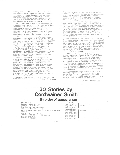 hardly any resemblance to those of whites and blacks today, save for the existence of group prejudice (compare the strained parallels of novels 1lie Dean R. Koontz THE DARK SYMPHONY or Robert Silverberg's THE TOWER OF GLASS to the situations in Dr. Linebarger's best fiction).
hardly any resemblance to those of whites and blacks today, save for the existence of group prejudice (compare the strained parallels of novels 1lie Dean R. Koontz THE DARK SYMPHONY or Robert Silverberg's THE TOWER OF GLASS to the situations in Dr. Linebarger's best fiction).
Dr. Linebarger's two great strengths as
a writer were the ability to develop intense emotional involvement in situations that were both utterly strange and entirely convincing - and to do this within the framework of a Stapledonian future history that created both logical and emotional resonances between the component stories.
His style was usually quite simple and straightforward (the image of Helen America, wired into her sailship, is intensely poetic, yet uses language that is not at all poetic) though full of euphony and imagery in later years. The resonances are crucial. Even quite a simple reference - as this ( iii 'The Burning of the Brain'): "An odd figure came out on the veranda. It was a pinlighter in full fighting costume" - takes on an emotional power for the reader who already knows about pinlighters from 'The Game of Rat and Dragon.'
When he neglected his strengths, Dr. Linebarger went to pieces as a writer. The second half of '01d North Australia' for example, is of interest more for its background and subplots like the induction of the Lord Boderick Eleanor than for the story of McBan, who seems too much like a character from TOM BROWN'S SCHOOL DAYS, who has stumbled into the wrong place (for that Matter, the contrived plot resolves nothing that could not have been settled in Lord Jestocost's office.)
Clearly, the author let his preoccupation with the religious message get out of control.
The same is true of the Casher O'Neill stories where he lets the concepts of the underpeople and animal-brained robots become banal (T'Ruth is patient because she is turtle-derivedr a robot feels oh so wise because he is owl-brained).
Stories like 'Think Blue, Count Two' and 'The Crime and Glory of Commander Suzdal' seem to lack meaning in relation to Dr. Linebarger's overall future history concept. And a few attempts at injecting humor into the serious epic of the Instrumentality ('Three to a Given Star' with its chicken people; and 'From Gustible' Planet' with its duck aliens ) can only be called pathetic.
Some writers who are said to be imitating Cordwainer Smith often seem to either imitate his mistakes or fail to recognize his virtue Silverberg, in NIGHTWINGS duplicated Smith at creating a background but didn't bother to resolve the story - there and in other novels he has his "messiahs" take baths instead of taking action to solve either their own or society's problems.
Samuel R. Delany, in THE FALL OF THE TOWERS, created a superficially Smith-like society. But Toron has not real history -futuristic and contemporary elements are thrown together willy-nilly. There is a lot of extremely poetic writing, but the situation never takes on a poetic reality -there is neither physical nor socio-histories reality behind it. Brian M. Stableford, who seems to be an imitator of Delany, makes the same mistakes.
Dr. Linebarger left science fiction an enduring legacy in the work he wrote as Cordwainer Smith. It remains to be seen whether that work will gain the real understanding and influence it deserves.
- John J. Pierce, 1971.
30 Stories by Cordwainer Smith
(in order of appearance)
War No. 81-q
Scanners Live in Vain
(Himself in Anachron)
The Game of Rat and Dragon
(Queen of the Afternoon)
(The Colonel Came Back From Nothing at All)
Mark Elf
The Burning of the Brain
WESTERN SCIENCE IS SO WONDERFUL
No, Nor Not Rogov
THE NANCY ROUTINE
~928 FBK 1950 unpublished GAL 1955 Oct unpublished unpublished SRN 1957 May WIF 1958 Oct WIF 1958 Dec WIF 1959 Feb SAT 1959 Mar
Early
Period
- 22 -
Document scaning and conversion provided by Peter Barker
Updated May 12, 2015. If you have a comment about these web pages please send a note to the Fanac Webmaster. Thank you.